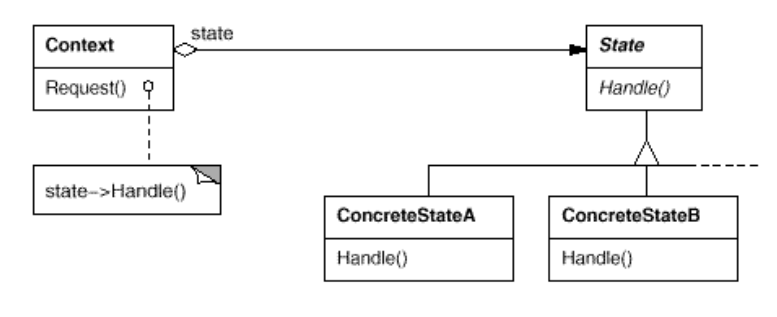20. State
- Intent:
- Allow an object to alter its behavior when its internal state changes.The object will appear to change its class.
- Also Known As:
- Objects for States
- Applicability:
- An object’s behavior depends on its state, and it must change its behavior at run-time depending on that state.
- Operations have large, multipart conditional statements that depend onthe object’s state. This state is usually represented by one or moreenumerated constants.
- Structure:

- Participants:
- Context
- defines the interface of interest to clients.
- maintains an instance of a ConcreteState subclass that defines the current state.
- State
- defines an interface for encapsulating the behavior associated with aparticular state of the Context.
- ConcreteState subclasses
- each subclass implements a behavior associated with a state ofthe Context.
- Context
- Collaborations
- Context delegates state-specific requests to the current ConcreteState object.
- A context may pass itself as an argument to the State object handling the request. This lets the State object access the context if necessary.
- Context is the primary interface for clients. Clients can configure a context with State objects. Once a context is configured, its clients don’t have to deal with the State objects directly.
- Either Context or the ConcreteState subclasses can decide which state succeeds another and under what circumstances.
- Consequences:
- 1.It localizes state-specific behavior and partitions behavior for different states.
- 2.It makes state transitions explicit.
- 3.State objects can be shared.
- Related Patterns:
- The Flyweight pattern explains when and how State objects can be shared.
- State objects are often Singletons.
- Code Sample: State

package com.sample.state;
public class State {
private String value;
public String getValue() {
return value;
}
public void setValue(String value) {
this.value = value;
}
public void method1(){
System.out.println("execute method1");
}
public void method2(){
System.out.println("execute method2");
}
}
---
package com.sample.state;
public class Context {
private State state;
public Context(State state) {
this.state = state;
}
public State getState() {
return state;
}
public void setState(State state) {
this.state = state;
}
public void method() {
if (state.getValue().equals("state1")) {
state.method1();
} else if (state.getValue().equals("state2")) {
state.method2();
}
}
---
public class Test {
public static void main(String[] args) {
State state = new State();
Context context = new Context(state);
//switch state1
state.setValue("state1");
context.method();
//switch state2
state.setValue("state2");
context.method();
}
}
